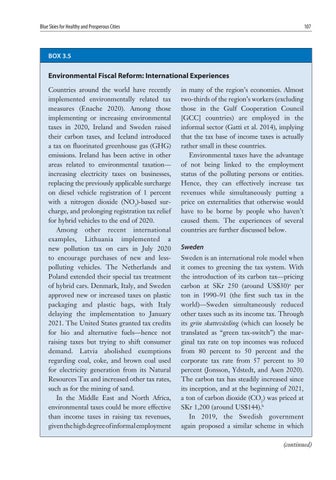Blue Skies for Healthy and Prosperous Cities
107
BOX 3.5
Environmental Fiscal Reform: International Experiences Countries around the world have recently implemented environmentally related tax measures (Enache 2020). Among those implementing or increasing environmental taxes in 2020, Ireland and Sweden raised their carbon taxes, and Iceland introduced a tax on fluorinated greenhouse gas (GHG) emissions. Ireland has been active in other areas related to environmental taxation— increasing electricity taxes on businesses, replacing the previously applicable surcharge on diesel vehicle registration of 1 percent with a nitrogen dioxide (NO2)-based surcharge, and prolonging registration tax relief for hybrid vehicles to the end of 2020. Among other recent international examples, Lithuania implemented a new pollution tax on cars in July 2020 to encourage purchases of new and lesspolluting vehicles. The Netherlands and Poland extended their special tax treatment of hybrid cars. Denmark, Italy, and Sweden approved new or increased taxes on plastic packaging and plastic bags, with Italy delaying the implementation to January 2021. The United States granted tax credits for bio and alternative fuels—hence not raising taxes but trying to shift consumer demand. Latvia abolished exemptions regarding coal, coke, and brown coal used for electricity generation from its Natural Resources Tax and increased other tax rates, such as for the mining of sand. In the Middle East and North Africa, environmental taxes could be more effective than income taxes in raising tax revenues, given the high degree of informal employment
in many of the region’s economies. Almost two-thirds of the region’s workers (excluding those in the Gulf Cooperation Council [GCC] countries) are employed in the informal sector (Gatti et al. 2014), implying that the tax base of income taxes is actually rather small in these countries. Environmental taxes have the advantage of not being linked to the employment status of the polluting persons or entities. Hence, they can effectively increase tax revenues while simultaneously putting a price on externalities that otherwise would have to be borne by people who haven’t caused them. The experiences of several countries are further discussed below.
Sweden Sweden is an international role model when it comes to greening the tax system. With the introduction of its carbon tax—pricing carbon at SKr 250 (around US$30)a per ton in 1990–91 (the first such tax in the world)—Sweden simultaneously reduced other taxes such as its income tax. Through its grön skatteväxling (which can loosely be translated as “green tax-switch”) the marginal tax rate on top incomes was reduced from 80 percent to 50 percent and the corporate tax rate from 57 percent to 30 percent (Jonsson, Ydstedt, and Asen 2020). The carbon tax has steadily increased since its inception, and at the beginning of 2021, a ton of carbon dioxide (CO2) was priced at SKr 1,200 (around US$144).b In 2019, the Swedish government again proposed a similar scheme in which (continued)






